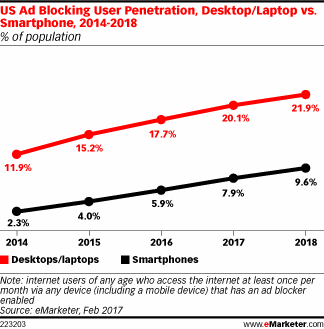Whether we like it or not, ad blocking is on the rise across the world. Yes, despite all that hard work marketers put into advertising, a lot of consumers want none of it—especially on mobile devices.
While some brands view ad blocking as a challenge to create more engaging content, others condemn the practice altogether. Regardless of where you stand on the issue, the practice of ignoring online advertising won’t go away anytime soon . . . although it’s not as bad as it might be perceived.
Analyst firm eMarketer has actually scaled back its estimates of ad blocking users in the US, reducing the number from 86 million to 75.1 million for 2017. While this is an improvement over previous estimates, more than one quarter (27.5 percent) of US internet users will still be using ad blockers this year. The younger the consumer, it seems, the less willing they are to view advertising. The firm predicts that 41.1 percent of millennials will utilize ad blockers in 2017 compared to GenX internet users at 26.9 percent. Baby boomers rarely use blockers, the firm suggested, predicting a usage rate of only 13.9 percent.
If you can’t block it, skip it. A study by online survey platform LaunchLeap found that 59 percent of millennial internet users watch ads only until they can skip them. Despite a majority of respondents displaying a desire to skip the ads, only 11 percent were blocking YouTube ads via an ad blocker. Surprisingly, 29 percent of US millennials reported watching YouTube ads all the way through.
Teenagers, in particular, don’t have much patience for mobile advertising, according to an October study of internet users from Kantar Millward Brown. Approximately 56 percent of 16-to-19-year-olds said they skipped ads “whenever they can” on a desktop computer, while 47 percent of teens said the same about ads on a mobile device.
Mobile ad blocking is especially prevalent in emerging markets such as China, India, Pakistan and Indonesia. Research by Priori Data suggests that 27 percent of mobile users in the Asian Pacific region use ad blockers on their mobile devices as of last March.
Is this bad news for the marketing industry? It depends on who you talk to. More than three quarters of marketers (76 percent) “think ad-blocking will be positive for the industry, encouraging greater creativity,” according to research by The Chartered Institute of Marketing.
On the contrary, IAB is strongly opposed to ad blocking, calling it, “a potentially existential threat to the industry.” Despite the company’s concerns, it does encourage brands to step it up in terms of customer experience.
“IAB research shows ad block use is caused by a general disdain for advertising and concern about the safety of user information,” the company explains on its website. “In our nationally representative survey, 89 percent of respondents who have installed ad-blocking technology reported using ad blockers to improve their experience. The ads deemed most intrusive are video ads that play automatically, screen takeovers, and blinking ads—all ad types that directly disrupt the consumption of content. These findings should be an alarm to everyone in media and marketing. We are mistreating our most valuable asset—our consumers. We can talk all we want about the ad-centered ‘value exchange’ between consumers and media. But until we commit to the cause of ever-improving user experiences, advertisers and media will be at risk.”
While marketers do their best to create authentic and engaging material that consumers will actually want to look at, online publishers are feeling the painful effects of ad blocking.
Ad blocking software could cost digital publishers over $27 billion by 2020, according to a report by Juniper Research. Paywalls are becoming more common, as fewer consumers agree to view ads that fund these outlets.
While 55 percent of US millennials pay for digital entertainment, only 25 percent are willing to pay for some kind of digital news service. A report by Business Insider notes that publications are questioning their pay-for-content models in order to reach this demographic.
A change, however, that might be shifting the scene in ad blocking may be looming on the horizon. According to advertising industry publication Campaign, YouTube is planning to eliminate its unskippable pre-roll 30-second ad unit by 2018.


